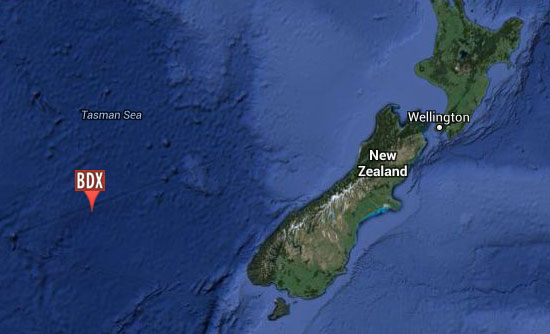For some reason yet to be determined, Dave has lost his Iridium email service. He still has phone and text capability, and is checking in frequently to let us know all is well … but for now, no email, so updates will be brief or will (as we do below) include some older updates that never got posted.
The following update was received over the phone.
“Going along real nicely here on a course headed for the northwest corner of South Island of New Zealand (Farewell Point.) We’re averaging over 8 knots the last couple days and likely for another couple of days as well. We do have a cold front weather system coming in Tuesday night, which will bring strong winds Tuesday evening into Wednesday, which should give us the push we need to take us down Cook Strait towards the southwest corner of the North Island, and into Wellington Harbor.
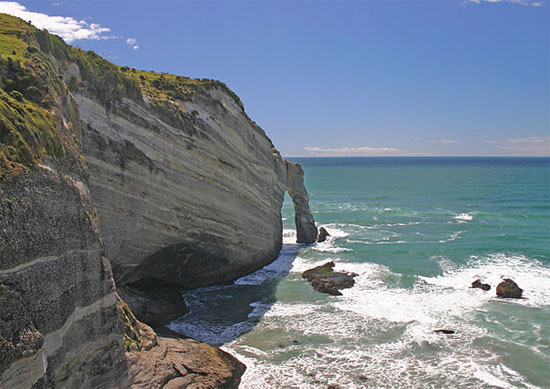 Farewell Point, Northenmost tip of South Island of New Zealand (web image)
Farewell Point, Northenmost tip of South Island of New Zealand (web image)
The bioluminescence is still around, though not to the spectacular degree I described it in the last post. Looking south towards Antarctica tonight, I can see a glow in the sky; similar to the sort of glow that a city makes when you are on the water and over the horizon. As we know there’s no civilization south of us here, so I can only think it’s the glow of the sun reflecting off the polar ice cap.
Had a fun time last night calling into the awards dinner for my friends in the Great Lakes Singlehanded Society. I spoke a bit and answered some questions. Thanks for the invite!
I know my Midwest and East Coast friends are getting hit with some dramatic weather of late … I’ll just say it’s summer down here … 55-60 out on the water. Food is getting down to final tally time. There are plenty of calories onboard … but the fun items on the menu are gone. I’ll make up for that, when I get to Wellington towards the end of the week. Over and out!”
:: As mentioned above, here’s an update though from some weeks ago that never got posted. It’s a navigation-related update, and its contents are still relevant to the current leg of the voyage. Enjoy!
Sailing long passages puts you in the middle of constantly shifting set of time and distance problems. These little mathematical calculations are always running through sailor’s minds when they’re not otherwise occupied with shipboard duties. Recently, I had one of those days where I had a whole bunch of interesting problems come up relative to navigation and latitudes.
I was trying to step back and figure out just how far it is from Cape Town to Wellington, NZ. Now I have a GPS locator onboard and it can give me a distance, but it works on what’s called the “Great Circle” route, which calculates the shortest distance along the curved surface of the Earth. Our own strategy though for sailing to Wellington is to stay along a particular latitude – namely 40 degrees south. We do this to maintain the best route through the least stormy weather. But back to the questions raised by the Great Circle method, let me explain a bit and also give you an experiment you can do on your own when you have a chance.
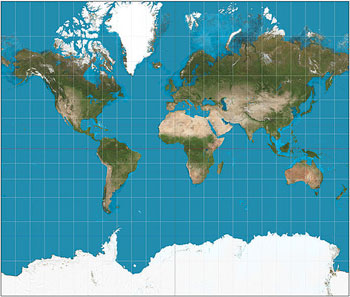 Over time, all of us spend a good deal of time looking at maps and charts of various places. These might show us our hometown, or a route to a someones’s house, or a map of the country or maybe the large world map on a classroom wall. Typically, these kinds of maps that we are so used to, are as a class called “Mercator Projections.” They represent the three-dimensional world as if it were laid out flat on a tabletop. The problem with this of course is that the world is not flat but rather beautifully round and by creating a world map that is flat and rectangular; you end up distorting the actual distances – particularly so, once you start considering areas closer to the polar ends of the earth.
Over time, all of us spend a good deal of time looking at maps and charts of various places. These might show us our hometown, or a route to a someones’s house, or a map of the country or maybe the large world map on a classroom wall. Typically, these kinds of maps that we are so used to, are as a class called “Mercator Projections.” They represent the three-dimensional world as if it were laid out flat on a tabletop. The problem with this of course is that the world is not flat but rather beautifully round and by creating a world map that is flat and rectangular; you end up distorting the actual distances – particularly so, once you start considering areas closer to the polar ends of the earth.
Here’s an amusing video clip from an episode of the TV show West Wing that deals with how the Mercator projections distort the actual size of landmasses as they actually exist on the globe.
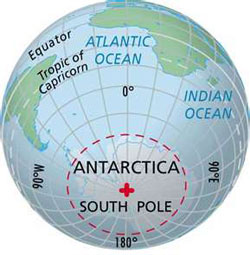 If you can find a globe and look at it carefully, then turn it so that the South Pole is facing you. Now if you can find a string, a shoelace or even take a piece of paper and cut a thin strip from it, then put one end on Cape Town South Africa and the other over to Wellington, NZ, you’ll see that the shortest route goes over the Southern Ocean and over Antarctica. This is what we mean by the “Great Circle” route. If you in were a plane, you could fly that route, but in a boat, it’s not an option. There are a number of reasons why, some of which are obvious such as the continent of Antarctica and the impenetrable ice, but also, the further south you get, the colder the water and the more dangerous the weather. So, that’s why we chose the route along 40 degrees south latitude. So, to get that distance, you have to work your way along that latitude with a measure of some kind and figure out the distance.
If you can find a globe and look at it carefully, then turn it so that the South Pole is facing you. Now if you can find a string, a shoelace or even take a piece of paper and cut a thin strip from it, then put one end on Cape Town South Africa and the other over to Wellington, NZ, you’ll see that the shortest route goes over the Southern Ocean and over Antarctica. This is what we mean by the “Great Circle” route. If you in were a plane, you could fly that route, but in a boat, it’s not an option. There are a number of reasons why, some of which are obvious such as the continent of Antarctica and the impenetrable ice, but also, the further south you get, the colder the water and the more dangerous the weather. So, that’s why we chose the route along 40 degrees south latitude. So, to get that distance, you have to work your way along that latitude with a measure of some kind and figure out the distance.
Now, while you still have that globe out, let’s take a look at something else. I believe I told you a while ago that the degree of longitude is widest at the equator at 69.172 miles (111.321) and gradually shrinks to zero at the poles. At around 40°N or S, where we are, the distance between a degree of longitude is 53 miles (85 km). But as you can see, at the South Pole and the North Pole, all the degrees of longitude come together into one point. That’s pretty interesting isn’t it?
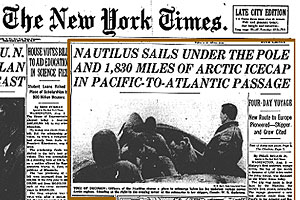 Here’s an interesting story I once read. Back in 1958, when the first Navy submarine (USS Nautilus) was able to travel under the ice pack of the North Pole and once they reached the pole, what do you think the navigator said when he called out his position? He sure must have enjoyed saying this … “90 degrees North latitude and ALL points longitude.” His meaning was that all the longitudes came together in one precise point at the North Pole!
Here’s an interesting story I once read. Back in 1958, when the first Navy submarine (USS Nautilus) was able to travel under the ice pack of the North Pole and once they reached the pole, what do you think the navigator said when he called out his position? He sure must have enjoyed saying this … “90 degrees North latitude and ALL points longitude.” His meaning was that all the longitudes came together in one precise point at the North Pole!
So, I spend a lot of time trying to figure out some of these things when I have time, but if you’d like to, you can do the calculations to figure out how far it is along latitude 40 degrees south from Cape Town, South Africa to Wellington, NZ. And if you can play the Great Circle game, how much shorter is that route than the one I am taking?
I think it’s worth noting that while I wrote this soon after leaving Cape Town, now that I’m approaching New Zealand I can see that my calculations at the time are still pretty much right on target.
– Dave, Bodacious Dream and Franklin (my onboard globe for this trip.)
Some Key Links: Email List Sign-Up :: Explorer Guides :: BDX Facebook

